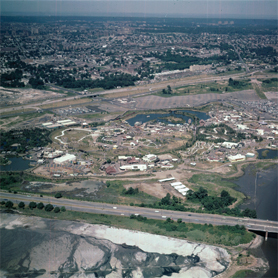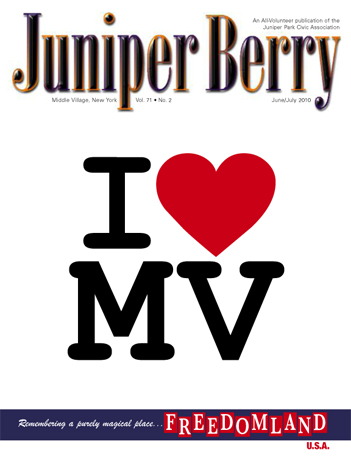Lasting 4 Short Years, it was like Disneyland in New York City
When you think of theme parks of the past was there any place more exciting than Freedomland? Just a short car trip to the Bronx and before you knew it you entered an area with a footprint designed to look like the map of the United States. Magically, one left the real world and was privy to historical American events realistically portrayed by actors who were second to none for talent and creativity.
Once in Freedomland you could hop on a trolley car, take a steamboat ride or tour the whole United States via the overhead bucket ride. You were driven around in antique cars and you could even get in a car and find yourself driving through San Francisco the night before the big earthquake! How creepy but exciting was that?
As you roamed the United States, within a short time you were in different neighborhoods that told the history of those neighborhoods. For a kid and even an adult, it was mesmerizing to take the journey! Talk to anyone today who visited Freedomland back in the day and their eyes light up and they start their recollection of the park as if it were yesterday.
To put everything in perspective Freedomland opened with seven different themed areas (later expanded to eight), each representing a location and era of U.S. History.
They were:
Little Old New York (1850-1900)
Chicago (1871)
The Great Plains (1803-1900)
San Francisco (1906)
The Old Southwest (1890)
New Orleans-Mardi Gras
Satellite City-The Future
State Fair Midway (added in 1962)
OK, are you ready for some excitement? Let’s take a trip through the United States, Freedomland style!
In NYC there was the horse-drawn streetcar, which took you to Chicago. Once in Chicago, there was the Great Chicago Fire of 1871 re-enacted by actors, a little too realistically, every twenty minutes, when they actually burned fake buildings using park visitors as volunteers! Can you just imagine that in this day and age? That’s how edgy and dangerous some of the exhibits were!
In the Great Plains there was a Pony Express, which was a transportation ride to the Old Southwest. In the old Southwest there was an Opera House and Saloon, featuring a soft drink bar and a thirty-minute stage show with a four-piece band, dancing girls, singers and Western comedians.
As you continued your travels west there was a stagecoach ride past a buffalo herd, through the Rocky Mountains that ended with a mock robbery by actors playing outlaws. In San Francisco there was Fisherman’s Wharf and a re-enactment of the San Francisco Earthquake of 1906.
In New Orleans-Mardi Gras there was a Civil War which consisted of a horse-drawn wagon adventure ride through re-creations of an American Civil War battle ground, camps, derailed trains and burning houses, which ends in the middle of a mock battle. At the end you were tired from being in a war zone!
At Satellite City-The Future there was Moving Lake Walk that featured an automated moving sidewalk across a lake!
It sounds unbelievable when you read about what Freedomland had back in 1960 and these were just a few of the attractions! There were many more and one trip to the park was never enough.
Even after seeing Disneyworld and all its glitz and glamour you have to still think that Freedomland had them beat because of the USA mapped footprint. As you “traveled” you could visualize yourself walking, riding, or boating across the United States and you recognized the various neighborhoods because of how beautifully they were portrayed. Within its 85 acres, Freedomland was able to squeeze in so many historical events with the realism of a current day movie.
The Disney Connection
As you can imagine, Freedomland didn’t just happen. Initially it was billed as the World’s Largest Entertainment Center. It was conceived by Cornelius Vanderbilt Wood. He was hired by Walt Disney in 1953, Wood was the person who selected the orange grove site in California where Disneyland was eventually built. He had previously worked in planning, construction, and management at Disneyland. He was fired by Disney for reasons not known, only theories exist, from charges of embezzlement to stealing the original concept for Freedomland from Disney and using it as his own. Also the thought was that Wood was taking too much credit for Disneyland. To this day there is no reference of him in any of the Disney literature. Wood was born in 1920 and died in 1992.
Also, because Freedomland didn’t make a profit it had a short shelf life from 1960 to 1964. One of the reasons for the money shortfall was the fact that the theme park was inaccessible by public transportation. Management found itself early on in several costly lawsuits because of injuries and various other events which resulted in litigation.
At the time of the emergence of Freedomland, however, it was as if the world was ready for it. The traditional New York City amusement area of Coney Island was in a state of continuing decline. Freedomland was highly accessible by automobile; but difficult to access by the heavily used NYC Subway System, requiring a connecting bus ride after taking an isolated subway line to the last stop. Coney Island, by contrast, was directly served by four separate subway lines. Ironically, Coney’s last integrated amusement park, Steeplechase Park, closed in 1964, the same year as Freedomland.
Larger than Disneyland
Here are the numbers to give you an idea of the actual size of the various structures on the land. Freedomland was built on the site of a former municipal landfill. The property was spread out over 205 acres but the actual amusement park itself was just 85 acres – larger than Disneyland’s 65 acres. The park could accommodate 32,000 visitors at one time (90,000 during the course of a day) and had 8 miles of navigable waterways and lakes, 10,000 newly planted trees, 18 restaurants and snack bars, and parking for 72,000 cars. The cost was $65 million to build.
In addition to 19 Academy Award Nominees, the research and design team consisted of 200 top artists and architects. Here’s a bit of trivia if you ever find yourself a contestant on Jeopardy, the original music for Freedomland was written by Jule Styne, composer of shows like Gypsy and Funny Girl and many other Broadway hits. Who knew?
Groundbreaking ceremonies for Freedomland took place on August 26, 1959. Disaster struck several months later on March 24, 1960, when six unfinished buildings were demolished by fire and had to be razed. Sounds like one of their exhibits but, no, it was real life!
Problems and Lawsuits
As magical as Freedomland was to young and old it had its many problems early on in its existence. When you consider how edgy some of the attractions were you realize how risky imaginations were in management. For instance, about a month after the park opened, a stagecoach overturned in the Great Plains section of the park. Ten people were injured. Three of the victims were hospitalized, including one with a snapped spine. The injured parties all filed lawsuits against the park. That certainly tells you how realistic the attractions were, when you were in the West, it was the Wild West!
Also in their first year, 1960, the front office was robbed of $28,836 by four armed men, who escaped in a boat. They were caught two weeks later and jailed the following year.
By the end of the 1961 season, just one year since its opening, Freedomland was already $8 million in debt. As it struggled to break even, the theme of the park was changed in an effort to appeal to more teenagers. You can say it went kitsch! The history exhibits and events would be joined by more conventional amusements, such as bumper cars, roller coasters, fireworks displays, and concerts, which broadened the appeal of the park.
These changes resulted in a lawsuit. In 1962, Benjamin Moore, a paint company that sponsored an exhibit in Satellite City, sued Freedomland for $150,000 in damages. Yes, another lawsuit! The company wanted to void their lease for their exhibit space, claiming “historical and educational” changes to the park’s character. The suit was later dismissed.
Some of the Freedomland rides and attractions still have a life. They were sold to other parks and relocated. Here’s a list of the survivors, some currently in storage waiting for the imaginations of tomorrow.
The Crystal Maze, Danny the Dragon, The Mine Caverns, and the Tornado Adventure The Santa Fe Railroad Depot and the San Francisco Railroad Depot
The Canadian,” one of the two sternwheelers from The Great Lakes Cruise,
* San Francisco Earthquake and Buccaneers
The site of Freedomland is now occupied by Co-Op City and the Bay Plaza Shopping Center and you can bet they have their share of banks and drug stores!
Everything comes to an end and when we’re young we can’t imagine nasty stuff like lawsuits or mean spirited people who would be responsible for ending some of the fantasy fun of years past. In the real world, however, it seems as though everything nowadays ends up as a drug store, a bank or a lawsuit!
This article on Freedomland may come under the heading of TMI, too much information! Maybe it’s better to keep the cherished memories we accumulate over our lifetime, sugar coated with only the good stuff. That’s not realistic, but it is comforting.
It gave me a sense of sadness to see the problems Freedomland encountered in its short shelf life. Who knew? I liked it better when I didn’t know. Truly “ignorance is bliss,” dumb, but blissful! After all when you journey into the real world of “research” you get the real life facts of events. Somehow though, we do need the memories of the good times and the magic of the Freedomlands in our world so we can make sense of the whole cosmic universe. No matter how you process it, we live in a crazy, mixed up world!




